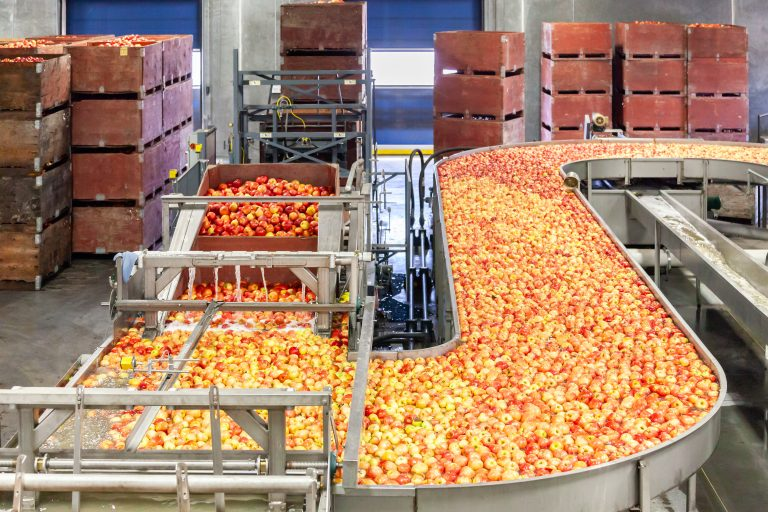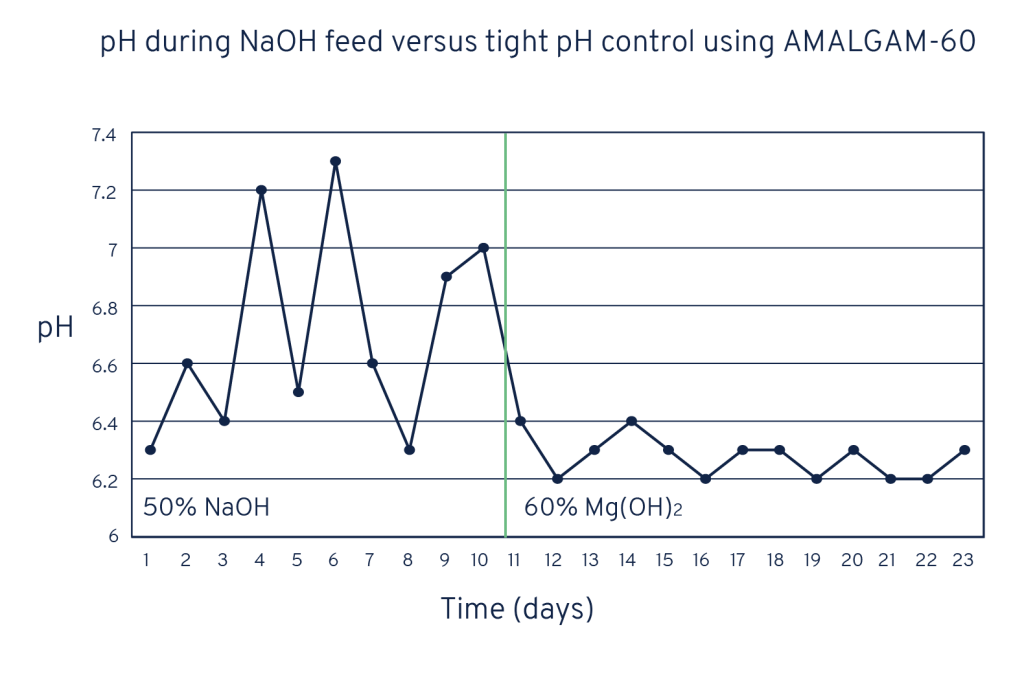
Fruit and vegetable processing plants generate large volumes of acidic wastewater that cannot be discharged without pretreatment.
The acidic waste from a fruit processing plant in the Pacific Northwest was generating an effluent with low pH that required adjustment before discharge into the municipal Publicly Owned Treatment Works (POTW).
For years, the plant had been using 50% NaOH (sodium hydroxide or caustic soda) to perform this function.
THE CHALLENGE
The plant managers were interested in looking for alternatives to caustic soda for the following reasons:
- Performance concerns regarding large swings in pH in the wastewater stream.
- Safety concerns of employees having to service tanks, pumps, and chemical feed lines that contain residual caustic, which is extremely hazardous to handle.
- Cost concerns due to price increases of 50% NaOH.
THE SOLUTION
AMALGAM-60
Costs less and is infinitely safer than caustic soda.
ACTI-Mag (60% Mg(OH)2 or 60% magnesium hydroxide) has a higher neutralizing value per pound than any other alkaline additive. This translates into a 40% reduction in chemical usage when compared with caustic soda, while being significantly safer for operators to handle and more nutritive for the microorganisms being maintained – making it the most cost-effective option.
Though 60% Mg(OH)2 is slightly more expensive than 50% NaOH (on a “per kg” basis), it is also 10% more concentrated. Therefore, the expectation was that 60% Mg(OH)2 would provide a reduced chemical usage rate, resulting in a cost saving.
SAFETY
The first observation was that magnesium hydroxide is infinitely safer than caustic soda. Despite being a more concentrated product, the pH of 60% Mg(OH)2 is only about 10.5 vs 14.0 for 50% NaOH. A pH of 10.5 is far below that of being corrosive either to skin or process equipment. In fact, Mg(OH)2 is so safe to use that it can be spilled on hands or clothes, allowed to dry, and then brushed off without causing any damage.
Mg(OH)2 has a low product pH because it exists in the form of a dispersed insoluble particle in a slurry. The solubility of Mg(OH)2 in neutral water is only 0.0009 g in 100 mL. When added into an acidic wastewater stream, the Mg(OH)2 particles dissolve to provide two moles of free hydroxide (OH-) that neutralize two moles of acid (H+). If Mg(OH)2 is overfed, the pH will not spike up, but remain near neutral.
Conversely, the high product pH of 50% NaOH is due to the free nature of the hydroxide in the product, which is also what makes caustic hazardous. As soon as NaOH enters a water stream, the hydroxides are immediately released, which can result in a high pH spike if overdosed.

For this reason, liquid caustic products NaOH and KOH (potassium hydroxide) are not recommended for biological (secondary) wastewater treatment processes where the performance of a microorganism population may suffer due to pH swings.
Liquid caustic products that contain “free hydroxide” are better suited for CIP (clean in place) cleaning processes, where a high pH is required for optimum removal of organic debris from the walls of vessels and pipes. Again, just as the “free hydroxide” in NaOH effectively dissolves crud off vessel walls, it also dissolves the skin off your hand!
PERFORMANCE
The next observation from the trial was the reduced fluctuations in the final effluent pH readings during Mg(OH)2 dosing. While using 50% NaOH, it was common to experience a swing of 1.0 full pH unit in the final effluent pH.
Because the permitted lower pH limit was 6.0, the plant chose to maintain the final effluent pH between 6.3 and 7.3 in order to ensure that the final pH was always above the permitted lower limit.
Using Mg(OH)2, the final effluent pH fluctuation was reduced to a range of 0.2 pH units. This improved pH control as a result of the controlled hydroxide release from the Mg(OH)2 particles into the flowing acidic wastewater stream. As a result, the final effluent pH was maintained between 6.2 and 6.4.

COST
Despite being more expensive on a “per kg” basis, the year-end cost to treat the wastewater system with 60% Mg(OH)2 was significantly lower than for 50% NaOH, due to a reduced Mg(OH)2 usage rate. There are two primary reasons that the Mg(OH)2 usage rate was far below that for caustic:
1. More concentrated product: 60% Mg(OH)2 versus 50% NaOH.
2. Every molecule of Mg(OH)2 releases two hydroxides. The following calculation shows how much “total hydroxide” (in moles of OH-) is released by the addition of one pound of each product into an acidic wastewater stream
CONCLUSION
The usage rate of 60% Mg(OH)2 by this plant was estimated to be 36% lower than their 50% NaOH usage rate the prior year. This result closely corresponded to the calculated prediction. The plant was thrilled with the safe chemical nature of the slurry, and the tighter control of the final pH readings of the effluent.
The significant reduction in chemical usage resulted in an overall cost saving for the plant. This, combined with the safety and performance improvements, has resulted in plant management installing a permanent 6,000 gallon Mg(OH)2 storage tank and feed system, in order to receive full truckload deliveries.
